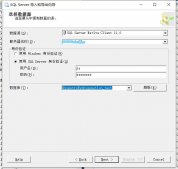Java與mongodb的連接
1. 連單臺mongodb
|
1
2
3
4
5
|
Mongo mg = new Mongo();//默認連本機127.0.0.1 端口為27017Mongo mg = new Mongo(ip);//可以指定ip 端口默認為27017Mongo mg = new Mongo(ip,port);//也可以指定ip及端口 |
2. 連雙臺mongodb
|
1
2
3
4
5
6
7
8
9
|
//ip為主機ip地址,port為端口號,dataBaseName相當于數據庫名DBAddress left = new DBAddress("ip:port/dataBaseName");DBAddress right = new DBAddress("ip:port/dataBaseName ");//若一個mongodb出現問題,會自動連另外一臺Mongo mongo = new Mongo(left, right); |
3. 連多臺mongodb
|
1
2
3
4
5
6
7
8
9
|
List<ServerAddress> mongoHostList = new ArrayList<ServerAddress>();mongoHostList.add(new ServerAddress("ip",port));mongoHostList.add(new ServerAddress("ip",port));mongoHostList.add(new ServerAddress("ip",port));Mongo mg = new Mongo(mongoHostList); |
Java獲取mongodb的數據庫名
1. 獲取mongodb的db(數據庫)
|
1
2
3
4
5
|
//dataBaseName相當于關系數據庫里的數據庫名,mongodb中若沒有該//數據庫名也不會報錯,默認mongodb會建立這個數據庫名,為空。DB db = mg.getDB(dataBaseName); |
注意:mongodb區分大小寫,程序中一定要注意
2.mongodb的db安全認證
|
1
2
3
4
5
6
7
8
9
10
11
12
13
|
//安全認證java代碼 返回true表示通過,false表示沒通過不能進行操作db.authenticate("userName", "password".toCharArray());if(db.authenticate("admin", "123".toCharArray())){ System.out.println("連接mongodb成功...");} else{ System.out.println("連接mongodb失敗...");} |
Java對mongodb的collection進行crud操作
1.得到mongodb中的db的collection(表)
|
1
2
3
4
5
6
7
8
9
|
//參數tableName相當于關系數據庫里的表名,//若mongodb中沒有該tableName,默認會創建該tableName,為空DBCollection users = db.getCollection(tableName);//列出庫的集合列表,相對于表對象Set<String> colls = db.getCollectionNames();for(String s : colls){}// 獲取單個集合DBCollection con = db.getCollection("users"); |
2.mongodb中的db的collection自增長主鍵
Mongodb中也像傳統的關系數據庫里表一樣,有主鍵(_id)概念,用來唯一標識他們。當用戶往collection中插入一條新記錄的時候,如果沒有指定_id屬性,那么mongodb會自動生成一個ObjectId類型的值,保存為_id的值。
_id的值可以為任何類型,除了數組,在實際應用中,鼓勵用戶自己定義_id值,但是要保證他的唯一性。
傳統的數據庫中,通常用一個遞增的序列來提供主鍵,在Mongodb中用ObjectId來代替,我們可以通過如下的方法來得到主鍵。
|
1
2
3
4
5
6
7
8
9
10
11
12
13
14
15
16
17
18
19
20
21
|
public class Tools {/** * 實現mongodb主鍵自增長的功能 * @param users * @param tableName * @return */public static long getNext(DBCollection users,String tableName){long incId = 0;try { DBObject ret = users.findAndModify( new BasicDBObject("_id", tableName), null, null, false, new BasicDBObject("$inc", new BasicDBObject("next", 1)), true, true); incId = Long.valueOf(ret.get("next").toString());} catch (Exception e) { e.printStackTrace();} return incId;}} |
3.java對collection進行插入操作
|
1
2
3
4
5
6
7
8
9
10
11
12
13
14
15
16
17
18
19
20
21
22
23
24
25
26
27
28
29
30
31
32
33
34
35
36
37
38
39
|
DB db = m.getDB("testdb");DBCollection con = db.getCollection("users");//普通添加BasicDBObject doc = new BasicDBObject();doc.put("name", "MongoDB");doc.put("type", "database");doc.put("count", 1);BasicDBObject info = new BasicDBObject();info.put("x", 203);info.put("y", 102);doc.put("info", info);con.insert(doc); //插入對象//特殊添加// 添加多個特殊數據(模式自由)for(int i = 1; i <=20; i++){con.insert(new BasicDBObject().append("i", i));}DBObject user_json = (DBObject)JSON.parse("{'user':[{'name':'AAA', 'age':'18'},{'name':'BBB', 'age':'19'}]}");con.insert(user_json);//添加JAVA對象// 添加java對象,對象要序列化Serializable接口UserInfo userinfo = new UserInfo("用戶甲AA", 1);User user = new User(1, "123", userinfo);ByteArrayOutputStream os = new ByteArrayOutputStream();ObjectOutputStream out = new ObjectOutputStream(os); out.writeObject(user);os.close(); out.close();con.insert(MonGoUtil.insertObject("user_info",os.toByteArray()));List<UserInfo> list = new ArrayList<UserInfo>();list.add(new UserInfo("List1", 1));list.add(new UserInfo("List2", 2));list.add(new UserInfo("List3", 3));ByteArrayOutputStream os = new ByteArrayOutputStream();ObjectOutputStream out = new ObjectOutputStream(os); out.writeObject(list);os.close(); out.close();con.insert(MonGoUtil.insertObject("lists",os.toByteArray())); |
4.java對collection的查詢操作
|
1
2
3
4
5
6
7
8
9
10
11
12
13
|
/** 輸出獲取到的文檔 **/public static void showDBCursor(DBCursor cur){ while(cur.hasNext()){ System.out.println(cur.next()); } System.out.println();} |
高級查詢
|
1
2
3
4
5
6
7
8
9
10
11
12
13
14
15
16
17
18
19
20
21
22
23
24
25
26
27
|
//查詢_id為30000 返回cust_Id的值 ,mongodb查詢都會返回主鍵的值System.out.println(users.findOne(new BasicDBObject("_id",30000),new BasicDBObject("cust_Id",true)));findAndRemove() 查詢_id=30000的數據,并且刪除users.findAndRemove(new BasicDBObject("_id", 30000));findAndModify介紹users.findAndModify( new BasicDBObject("_id", 28), //查詢_id=28的數據 new BasicDBObject("cust_Id", true), //查詢cust_Id屬性 new BasicDBObject("notice_Id", true), //按照notice_Id排序 false, //查詢到的記錄是否刪除,true表示刪除 new BasicDBObject("province_Id", "100"), //將province_id的值改為100 true, //是否返回新記錄 true返回,false不返回 true //如果沒有查詢到該數據是否插collection true入庫,false不入)); |
查詢所有數據
|
1
2
3
4
5
6
7
|
//列出所有文檔BasicDBObject query = new BasicDBObject();System.out.println("列出"+ con.getName() +"集合(表)的所有文檔...");showDBCursor(con.find()); |
查詢JAVA對象
|
1
2
3
4
5
6
7
8
9
10
11
12
13
14
15
|
String key = "user_info";BasicDBObject query = new BasicDBObject();query.put(key, new BasicDBObject("$exists", true));byte[] b = (byte[])con.findOne(query).get(key);InputStream inputStream = new ByteArrayInputStream(b);ObjectInputStream in = new ObjectInputStream(inputStream); User users = (User) in.readObject();System.out.println("用戶對象_json:" + JSONArray.fromObject(users)); |
單一條件查詢(數字)
|
1
2
3
4
5
|
BasicDBObject query = new BasicDBObject();query.put("i", 11);showDBCursor(con.find(query)); |
單一條件查詢(字符串)
|
1
2
3
4
5
|
BasicDBObject query = new BasicDBObject();query.put("name", "MongoDB");showDBCursor(con.find(query)); |
$ne非等于查詢
|
1
2
3
4
5
|
BasicDBObject query = new BasicDBObject();query.put("name", new BasicDBObject("$ne", "MongoDB"));showDBCursor(con.find(query)); |
根據列名查詢
|
1
2
3
4
5
6
7
|
System.out.println("查詢有'type'字段的數據..."); // false表示沒有BasicDBObject query = new BasicDBObject();query.put("type", new BasicDBObject("$exists", true)); // falseshowDBCursor(con.find(query)); |
單字段and查詢
|
1
2
3
4
5
6
7
|
System.out.println("單字段and條件的使用,i>=2 and i<5 ,i:[2,5)...");BasicDBObject query = new BasicDBObject();query.put("i", new BasicDBObject("$gte", 2).append("$lt", 5));showDBCursor(con.find(query)); |
多字段and查詢
|
1
2
3
4
5
6
7
8
9
|
BasicDBObject query = new BasicDBObject();();query.put("name", "MongoDB");query.put("type", "database");System.out.println(con.findOne(query));showDBCursor(con.find(query)); |
單字段or查詢
|
1
2
3
4
5
6
7
8
9
10
11
12
13
|
System.out.println("單字段or條件的使用,i<2 or i>=18...");BasicDBList values = new BasicDBList(); values.add(new BasicDBObject("i", new BasicDBObject("$gte", 18))); values.add(new BasicDBObject("i", new BasicDBObject("$lt", 2)));BasicDBObject query = new BasicDBObject();();query.put("$or", values);showDBCursor(con.find(query)); |
多字段or查詢
|
1
2
3
4
5
6
7
8
9
10
11
12
13
|
// "多字段or條件的使用,name:'MongoDB' or x:'203'..."BasicDBList values = new BasicDBList(); ();values.add(new BasicDBObject("name", "MongoDB")); values.add(new BasicDBObject("x", 203));BasicDBObject query = new BasicDBObject();();query.put("$or", values);showDBCursor(con.find(query)); |
$in 查詢
|
1
2
3
4
5
6
7
8
9
10
11
12
13
14
15
|
System.out.println("in條件的使用$in...");BasicDBList values = new BasicDBList(); ();for (int i = 1; i <=10; i++) { values.add(i);}BasicDBObject query = new BasicDBObject();();query.put("i", new BasicDBObject("$in", values));showDBCursor(con.find(query)); |
Order By 排序查詢
|
1
2
3
|
System.out.println("排序[1=asc,-1=desc]...");showDBCursor(con.find(query).sort(new BasicDBObject("i", -1))); |
分頁查詢
|
1
2
3
4
5
6
7
8
9
10
11
12
13
14
15
16
17
|
// "分頁查詢的使用,總數據量:"+con.find(query).count()con.find(query).limit(1); // 只取第1條數據con.find(query).skip(1).limit(1); // 從1開始取1條數據,下標從0開始con.find(query).sort(new BasicDBObject("i", -1)).skip(0).limit(5); // DESC后取5條數據//findAndRemove()方法,刪除查詢到的數據,刪除后的結果集con.findAndRemove(new BasicDBObject("i", 1));showDBCursor(con.find(query));con.findAndRemove(new BasicDBObject("i", new BasicDBObject("$in", values))); //【注意:多個數值無效】showDBCursor(con.find(query)); |
(not) OR (not in)查詢
|
1
2
3
4
5
6
7
|
System.out.println("not,not in條件的使用$not");BasicDBObject query = new BasicDBObject();();query.put("i", new BasicDBObject("$not", new BasicDBObject("$in", values)));showDBCursor(con.find(query)); |
Like模糊查詢
|
1
2
3
4
5
6
7
|
System.out.println("like查詢的使用...");BasicDBObject query = new BasicDBObject();();query.put("type", MonGoUtil.getLikeStr("a"));showDBCursor(con.find(query)); |
根據字段類型查詢
|
1
2
3
4
5
6
7
8
9
10
11
12
13
14
15
|
System.out.println("根據數據類型查詢,字符類型...");BasicDBObject query = new BasicDBObject();();query.put("name", new BasicDBObject("$type", 2)); //字節showDBCursor(con.find(query));System.out.println("根據數據類型查詢,整型...");BasicDBObject query = new BasicDBObject();();query.put("i", new BasicDBObject("$type", 16));showDBCursor(con.find(query)); |
返回查詢的部分字段
|
1
2
3
|
//"查詢數據的部分字段,1表示只返回本字段,0表示返回除此字段之外的字段"con.find(new BasicDBObject("name", MonGoUtil.getLikeStr("b")), new BasicDBObject("name", 1)); |
5.java對collection的更新操作
|
1
2
3
4
5
6
7
8
9
10
11
12
13
14
15
|
//查詢id為300的記錄,將cust_Id的值更新為6533615,一定要注意大小寫,以及數據//類型,返回值為int表示所影響的記錄條數//可以用users.findOne(new BasicDBObject("_id",300));查看下,會發現這條記錄//只返回兩個字段了,分別為_id,cust_Id,別的字段都刪除了。users.update(new BasicDBObject("_id",300), new BasicDBObject ("cust_Id","6533615")).getN();// 參數3表示數據庫不存在是否添加(默認false),參數4表示是否多條修改(false只修改1條)con.update(new BasicDBObject("name", "MongoDB"),new BasicDBObject("$set", new BasicDBObject("type", "修改后的type"))).getN();con.update(new BasicDBObject("name", "MongoDBs"),new BasicDBObject("$set", new BasicDBObject("type", "修改后的type")), true, true).getN(); |
6.java對collection的刪除操作
|
1
2
3
4
5
6
7
8
9
10
11
12
13
14
15
16
17
18
19
20
21
22
23
24
25
26
27
|
/移除cust_Id為6533615的數據。注意 用remove方法不釋放磁盤空間,//mongodb只在collection中做了標志,沒有正在刪除。users.remove(new BasicDBObject("cust_Id","6533615")).getN();//移除id>=1的數據users.remove(newBasicDBObject("_id",new BasicDBObject("$gte",1))).getN();//移除整個collection,drop也不釋放磁盤空間users.drop();// 根據條件刪除文檔(數據)BasicDBList rls = new BasicDBList();for (int i = 11; i <= 20; i++) { rls.add(i);}query.put("i", new BasicDBObject("$in", rls));con.remove(query); |
7.讀取mongodb中Binary Data類型數據
|
1
2
3
|
Binary binary = (Binary) doc.get("Data");byte[] data=binary.getData(); |
原文鏈接:https://www.jianshu.com/p/31daf8d67c11















